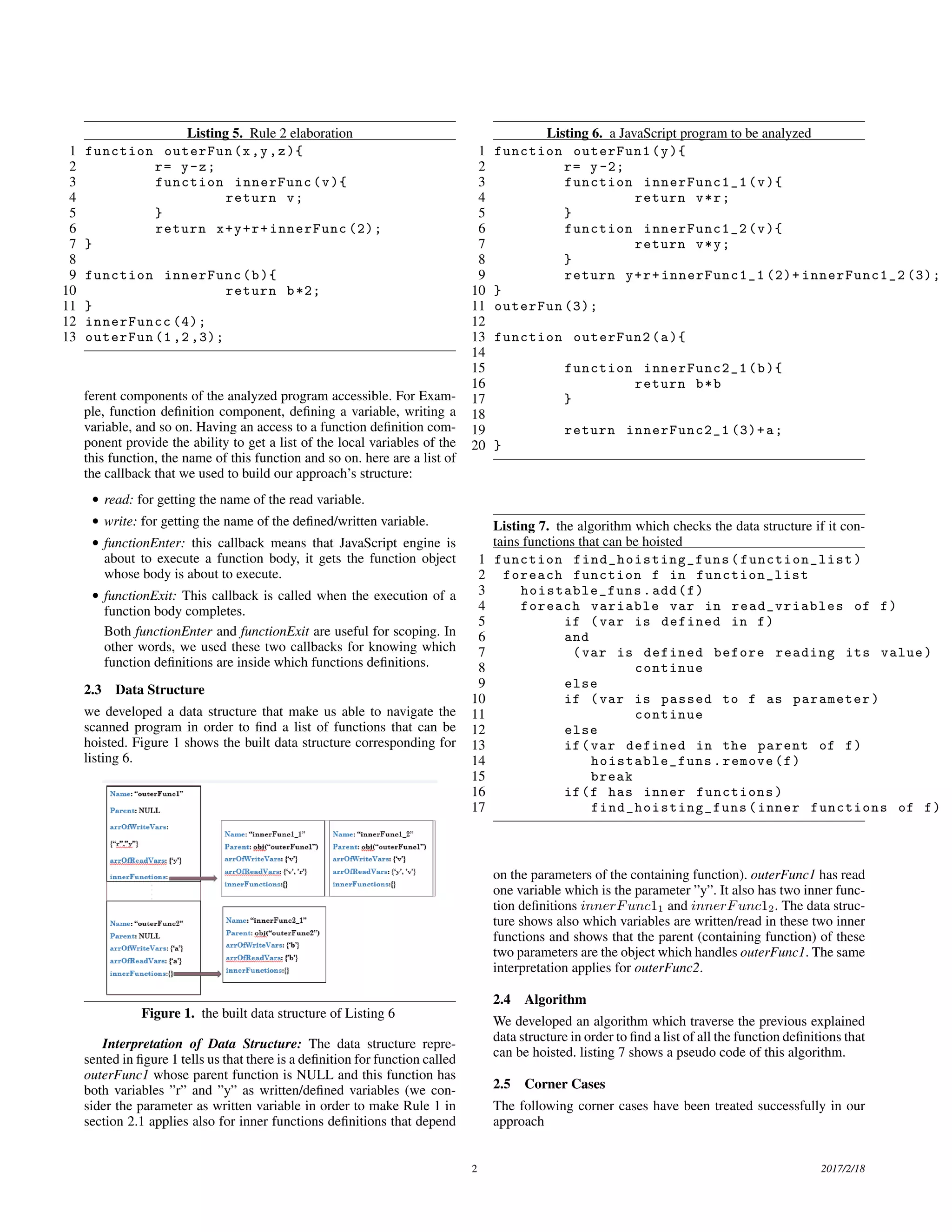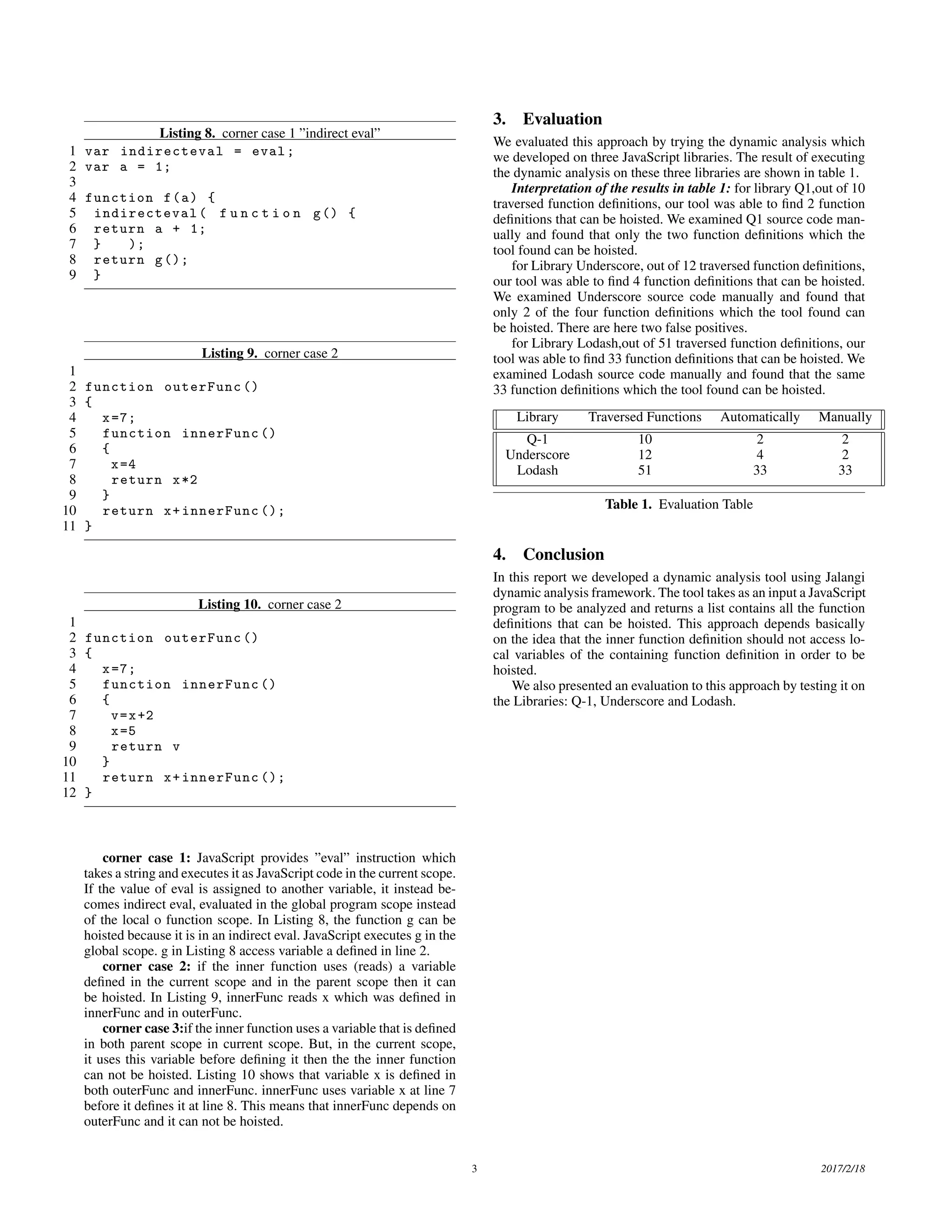The document presents a dynamic analysis approach for identifying hoistable nested function definitions in JavaScript using the Jalangi framework. It details the rules governing function hoisting and evaluates the method on libraries Q1, Underscore, and Lodash, achieving varying degrees of accuracy. The analysis revealed essential insights into function definitions that can be hoisted, contributing to performance optimization in JavaScript coding.
![Hoisting Nested Functions TUD9 Listing 1. Nested Function Definition 1 function outerFun(x,y,z){ 2 function innerFunc(a){ 3 return a*a; 4 } 5 return x+y+z+innerFunc (2); 6 } 7 outerFun (1 ,2 ,3); Abstract In this report, we produce a dynamic analysis approach which ex- tracts all function definitions that can be hoisted using dynamic analysis framework Jalangi framework. This approach was eval- uated on the following JS Libraries: Q1, Underscore and Lodash. The accuracy of this approach was 100%, 50%, and 100% respec- tively. Keywords: Hoisting Functions - Nested Functions- Dynamic Analysis. 1. Motivation and Introduction JavaScript allows the developer to define functions inside other functions. This has a significant performance drawback. Every time the containing function is called, the inner function is created. If we have a JavaScript program which has two functions defined in a nested way. This JavaScript program has slower execution time than it’s hoisted version; another version of the same program with the two functions defined at the same level [not nested]. Listing 1 shows a JavaScript program that defines two nested functions and Listing 2 shows the hoisted version of the same JavaScript Program. The goal of this project is to create a dynamic analysis tool that is able to analyze a JavaScript program in order to find a list of all functions that can be hoisted. In other words, the dynamic analysis approach must find all function definitions that: • are defined inside other function definitions . • can be defined outside the surrounding function definition. The rest of this report discusses the approach we followed to implement the dynamic analysis from two points of views: data structure and algorithm. After that we provide an evaluation of our work. 2. Approach 2.1 Hoisting Rules: There are two basic Rules which tell when a function definition can be hoisted. These rules are: • Rule 1: The inner function must not depend on the local vari- ables of the containing function (parameters or defined vars). Listing 2. Hoisted Version of Listing1 1 function innerFunc(a){ 2 return a*a; 3 } 4 function outerFun(x,y,z){ 5 return x+y+z+innerFunc (2); 6 } 7 outerFun (1 ,2 ,3); Listing 3. Rule 1 elaboration 1 function outerFun(x,y,z){ 2 function innerFunc (){ 3 return x*x; 4 } 5 return x+y+z+innerFunc (); 6 } 7 outerFun (1 ,2 ,3); Listing 4. Rule 1 elaboration 1 function outerFun(x,y,z){ 2 r= y-z; 3 function innerFunc(v){ 4 return v*r; 5 } 6 return x+y+r+innerFunc (2); 7 } 8 outerFun (1 ,2 ,3); In Listing 3 we can not hoist innerFuncc because it uses the parameter x of outerFunc. In Listing 4 we can not also hoist innerFuncc because it uses the local variable r of outerFunc • Rule 2: when a function definition can be hoisted, we should make sure that there is no other function definition at the same level of the containing function that has the same name. Listing 5 elaborates this rule. The innerFuncc in line 3 of listing 5 satisfy rule 1. It does not depend on local variables of the containing function but we Can not hoist it because there is another function definition (inner- Funcc at line 9 at the same level of the containing function out- erFunc. 2.2 Used Callbacks We analyzed the program dynamically using Jalangi dynamic anal- ysis framework. Jalangi provides a set of callbacks that make dif- 1 2017/2/18](https://image.slidesharecdn.com/main-170423113640/75/Hoisting-Nested-Functions-1-2048.jpg)

